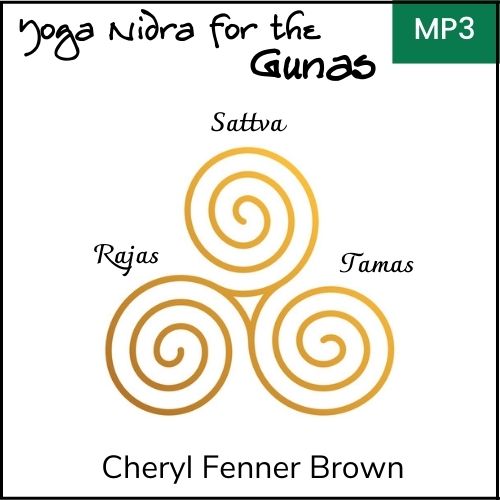- STORE
- >
- Yoga Nidra
- >
- Yoga Nidra MP3
- >
- Yoga Nidra for the Gunas (mp3)
Yoga Nidra for the Gunas (mp3)
According to Samkhya texts, such as the Bhagavad Gita, and Shvetashvatra Upanishad, reality consists of Prakriti and Purusha, or matter and consciousness. Prakriti is the cosmic material that makes up everything we can see, hear, smell, taste, and feel. It is the form of the unconscious material world, including our bodies and minds; it is finite and constantly changing. Purusha is the underlying energy, intelligence, and creative force that gives rise to the material world; it is infinite, invisible, and unchanging. We suffer when we identify with Prakriti, the ever-changing circumstances of our lives causing us to avoid, desire, and grasp. Our unchanging souls made of Purusha are entangled in material bodies made of Prakriti, and our senses keep us entangled.
As the creative force of Purusha interacts with the material world of Prakriti, three ‘strings’ or Gunas combine to form everything. They are Rajas or action, Tamas or inaction, and Sattva or balance. These forces combine in different variations to make up the totality of our external experience.
- Rajas is associated with doing; it is exciting, restless, and passionate; it keeps us moving forward and changing. When Rajas is dominant, the body is restless, the mind active, and the emotions excitable and anxious. We can be impulsive, judgmental, selfish, quick to anger, and always seeking the next new thing. Rajas leads to 'dukkha' or the pain and unhappiness associated with craving, desire, grasping, and regret.
- Tamas is associated with inaction and stagnation; it is heavy, dark, and inert. When Tamas is dominant, the body is sluggish, the mind disinterested, and emotions depressed. As a result, we lose interest in spiritual transformation and lose sight of the true nature of reality. Tamas leads to 'moha' or bewilderment and distraction of infatuation and delusion.
- Sattva is associated with balance. It is buoyant, luminous, and enlightening. When Sattva is dominant, the body is balanced, the mind clear, and the emotions peaceful. Sattva leads to 'sukha' or pleasure, bliss, happiness, ease, and joy.
- Rajas Yoga Nidra (48:09) - A meditation exploring the tendency to get stuck in action and doing.
- Tamas Yoga Nidra (44:31) - A meditation exploring the tendency to get stuck in stagnancy and inertia.
- Sattva Yoga Nidra (47:50) - A meditation exploring ways to create balance and harmony in our behavior.
PLEASE READ: The MP3 files CANNOT be live-streamed, they must be downloaded first onto a computer, then you can listen to them from your computer, or load them onto your phone or other listening device. You will receive a receipt from your order that contains the download links. Please be patient, sometimes it takes a few minutes.
HAVING TROUBLE DOWNLOADING? If the files do not seem to download, please right-click the over the file name and open in an "incognito" window in your browser.
DID YOU KNOW:
- Scripts for these meditations are also available for purchase.
- I teach live Yoga Nidra classes.
- Want to learn how to write your own scripts? Join this 10-hour Yoga Nidra Training (CEC's for Yoga Alliance available)
- View all of the Yoga Nidra resources.


